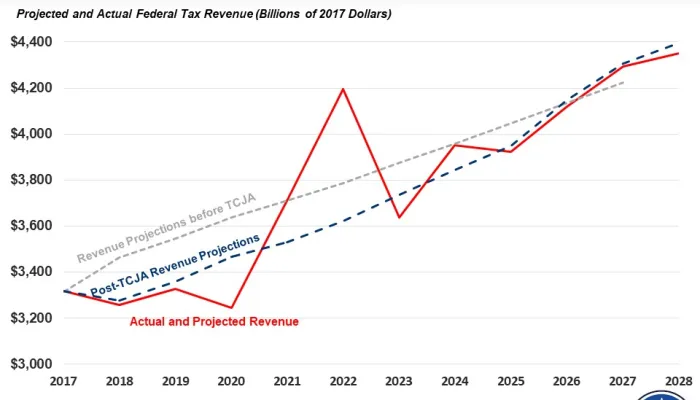2020 Federal Tax Brackets Are Here
The Internal Revenue Service (IRS) has released its tax year 2020 inflation adjustments for more than 60 federal tax provisions. To make these adjustments, the IRS used the Chained Consumer Price Index (C-CPI) – as required by the Tax Cuts and Jobs Act – to calculate the past year’s inflation at 1.6 percent.
The 2019 figures will be used for income earned in 2019 (tax returns filed in 2020), while the 2020 figures will be used for income earned in 2020 (tax returns filed in 2021).
Individual Income Tax Rates and Brackets
Income thresholds for all tax brackets are adjusted upward to account for inflation and to limit "bracket creep," which would otherwise push taxpayers into higher tax brackets over time. The top marginal tax rate of 37 percent will now apply to single individuals and heads of households earning over $518,400 instead of $510,300 and to married couples filing jointly earning more than $622,050 instead of $612,350.
Table 1: 2019 and 2020 Tax Rates for Single Individuals
| Rate | 2019 Taxable Income Over | 2020 Taxable Income Over |
|---|---|---|
| 10% | $0 | $0 |
| 12% | $9,700 | $9,875 |
| 22% | $39,475 | $40,125 |
| 24% | $84,200 | $85,525 |
| 32% | $160,725 | $163,300 |
| 35% | $204,100 | $207,350 |
| 37% | $510,300 | $518,400 |
Table 2: 2019 and 2020 Tax Rates for Married Individuals Filing Jointly and Surviving Spouses
| Rate | 2019 Taxable Income Over | 2020 Taxable Income Over |
|---|---|---|
| 10% | $0 | $0 |
| 12% | $19,400 | $19,750 |
| 22% | $78,950 | $80,250 |
| 24% | $168,400 | $171,050 |
| 32% | $321,450 | $326,600 |
| 35% | $408,200 | $414,700 |
| 37% | $612,350 | $622,050 |
Table 3: 2019 and 2020 Tax Rates for Heads of Households
| Rate | 2019 Taxable Income Over | 2020 Taxable Income Over |
|---|---|---|
| 10% | $0 | $0 |
| 12% | $13,850 | $14,100 |
| 22% | $52,850 | $53,700 |
| 24% | $84,200 | $85,500 |
| 32% | $160,700 | $163,300 |
| 35% | $204,100 | $207,350 |
| 37% | $510,300 | $518,400 |
Standard Deduction
For tax year 2020, the standard deduction will increase by $200 for single taxpayers and for married individuals filing separate returns, by $400 for married couples filing joint returns, and by $300 for heads of households. Taxpayers can choose to take either the standard deduction or the sum of all their itemized deductions, such as the mortgage interest deduction, state and local taxes (up to $10,000), charitable contributions, and medical expenses.
Table 4: 2019 and 2020 Standard Deduction
| Filing Status | 2019 Deduction Amount | 2020 Deduction Amount |
|---|---|---|
| Single or Married Filing Separately | $12,200 | $12,400 |
| Married Filing Jointly | $24,400 | $24,800 |
| Head of Household | $18,350 | $18,650 |
Earned Income Tax Credit
The maximum Earned Income Tax Credit (EITC) increased modestly from the 2019 EITC parameters by about $10 for childless filers and about $60-$100 for filers with children.
Table 5: 2019 and 2020 Earned Income Tax Credit Parameters
| Filing Status | No Children | One Child | Two Children | Three or More Children | |
|---|---|---|---|---|---|
| 2019 Single, Married Filing Jointly, or Head of Household | Income at Maximum Credit | $6,920 | $10,370 | $14,570 | $14,570 |
| Maximum Credit | $529 | $3,526 | $5,828 | $6,557 | |
| 2020 Single, Married Filing Jointly, or Head of Household | Income at Maximum Credit | $7,030 | $10,540 | $14,800 | $14,800 |
| Maximum Credit | $538 | $3,584 | $5,920 | $6,660 |
Other Provisions
For calendar year 2020, the gift tax exclusion will be $15,000, the same as in calendar year 2019. This means the first $15,000 in gifts received are tax-free.
The estate tax exclusion for calendar year 2020 will be $11.58 million, up from $11.4 million in calendar year 2019. The exclusion is essentially doubled for married couples, so a couple could pass down $23.2 million before being subject to the estate tax.
The Child Tax Credit, which is not indexed, will remain at $2,000. The refundable portion that can be given to a taxpayer with no tax liability is indexed but will remain at $1,400.
Maximum contributions to Health Savings Accounts (HSAs) will be $3,550 (up $50 from 2019) for taxpayers insured with self-only coverage and $7,100 for taxpayers with family coverage (up $100 from 2019). The Catchup Maximum Contribution Limit for taxpayers aged 55 and older remains unchanged at $1,000.
In 2020, the contribution limit for employees who participate in 401(k) plans will increase by $500 to $19,500, and the catch-up contribution limit for employees aged 50 and over who participate in these plans will increase from $6,000 to $6,500. The maximum contribution to Individual Retirement Accounts (IRAs) remains unchanged at $6,000 ($7,000 for employees aged 50 and over).


